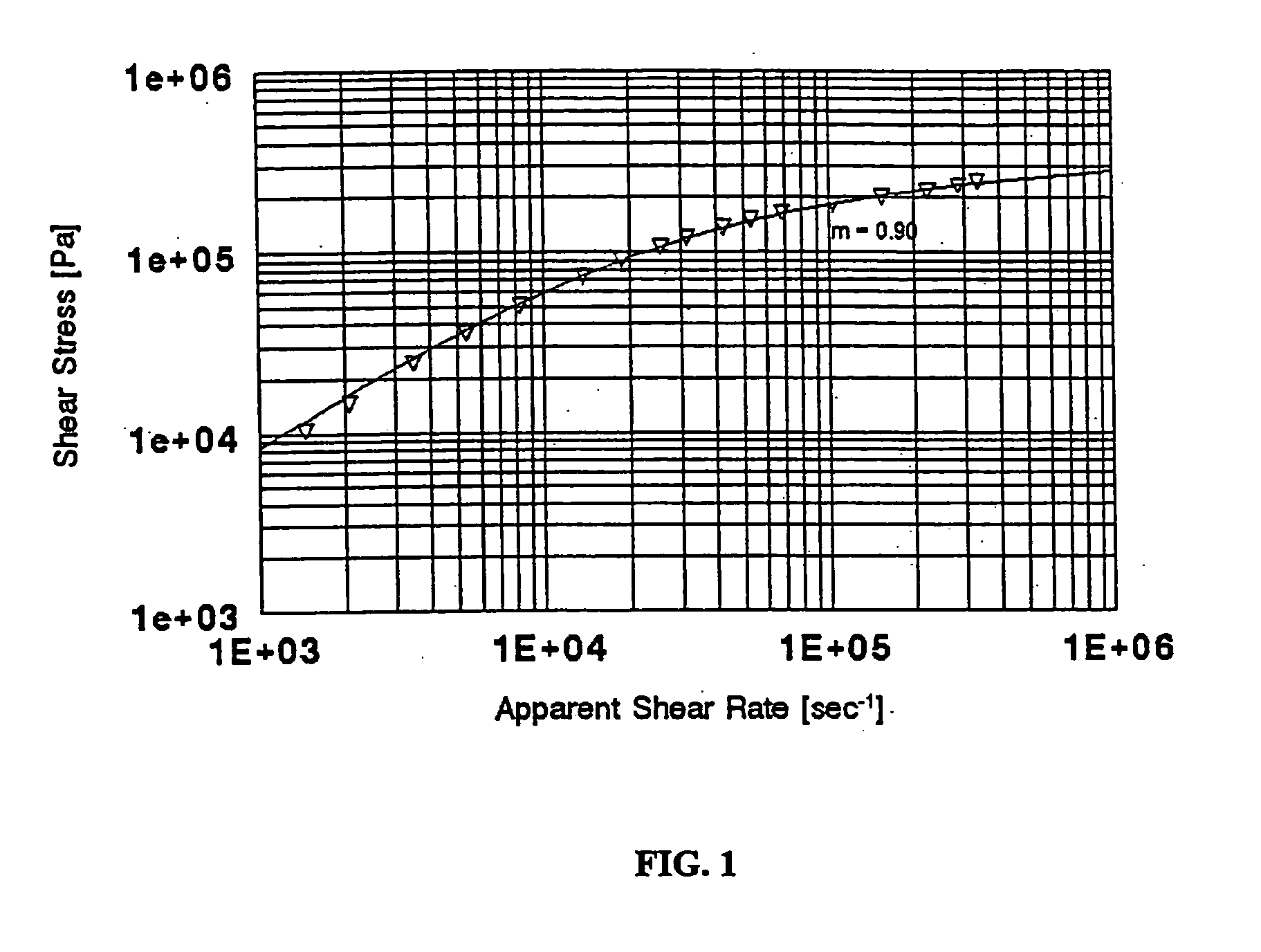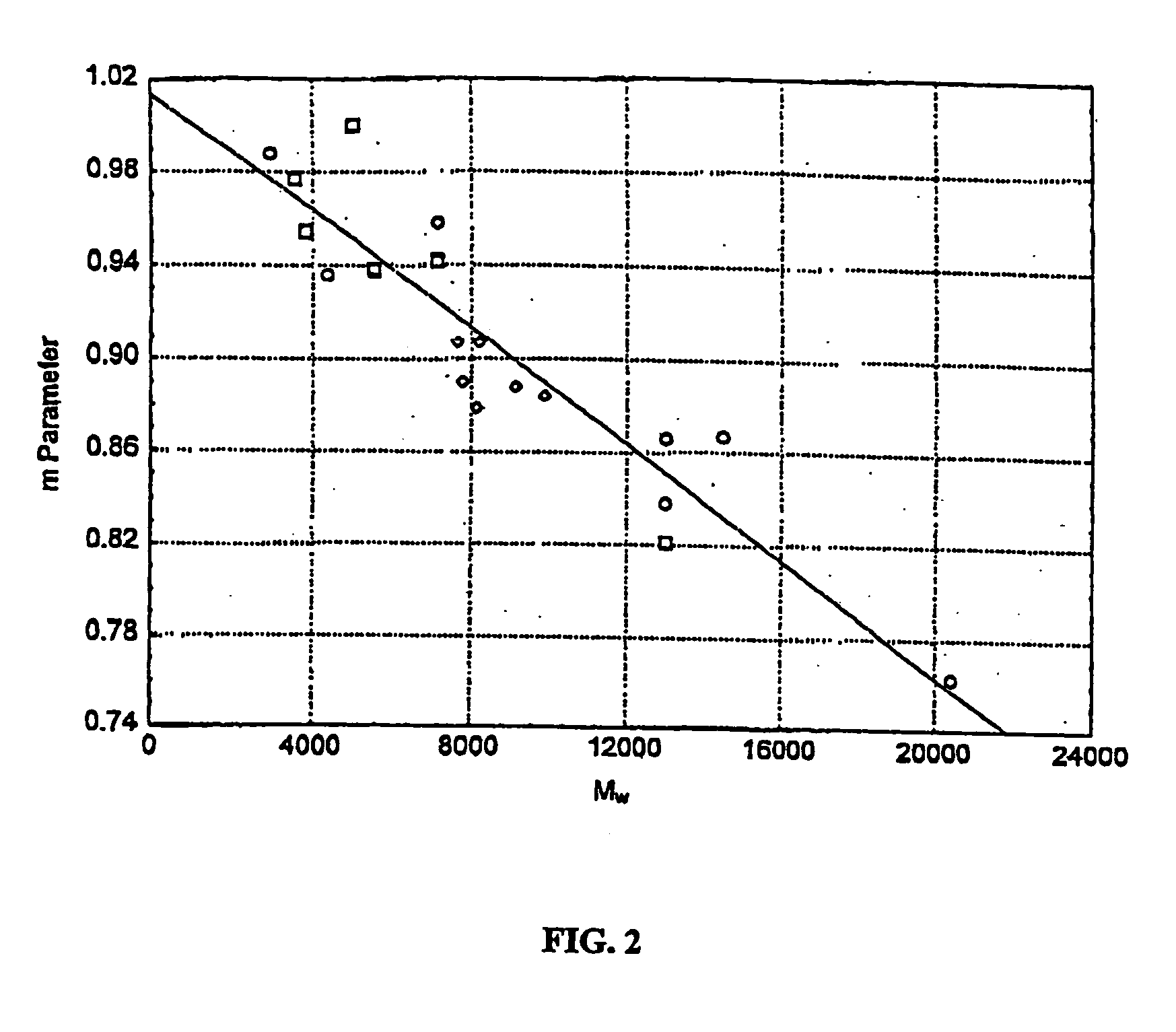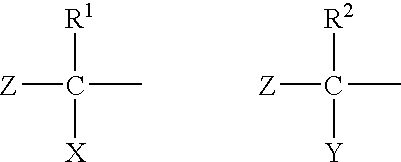Radiation-curable coatings suitable for high-speed application onto optical fibers
a technology of optical fibers and coatings, applied in the field of optical fibers, can solve the problems of attenuation of the signal transmission capability of optical fibers, degree of uniformity of coatings, and certain problems, and achieve the effects of improving properties, high shear rates, and high shear rates
- Summary
- Abstract
- Description
- Claims
- Application Information
AI Technical Summary
Benefits of technology
Problems solved by technology
Method used
Image
Examples
example 1
[0086] This example describes the procedure for obtaining an m value for an uncured, radiation-curable coating composition, whether it be a primary, secondary, ink or matrix composition.
[0087] About 200 ml of an uncured coating composition to be tested is introduced into a cup. The sample and cup are then placed in a temperature-controlled high-pressure chamber, along with the testing device, a PAAR HVA6 Capillary Viscometer.
[0088] This viscometer is provided with a capillary tube having a diameter of 0.6 mm and a length of 10 mm. A pressure transducer is provided to measure any pressure drop in liquid flowing through the capillary, and an optical flowmeter is provided in a burette connected to the capillary tube to measure the flow rate of the liquid through the capillary tube.
[0089] The temperature of the composition in the cup is then brought to 25° C.
[0090] After the temperature of the composition is attained, the pressure in the chamber is slowly increased by introducing ei...
example 2
[0097] This example provides examples of preferred processing methodologies, including stoichiometry, useful in the preparation of preferred urethane oligomers.
A. Preparation of Oligomer A
[0098] An end-capping component, hydroxyethylacrylate (HEA), is reacted with 2,4-TDI in a hydroxy:isocyanate equivalents ratio of about 1:2, to provide an intermediate compound having acrylate and isocyanate groups. In a second step, a low molecular weight diol, polytetramethylene glycol (MW 650) is added to and reacted with the intermediate compound. The polyol is added in a hydroxy:hydroxy equivalents ratio of about 1:1 with respect to the end-capping component. The resulting compound is a urethane oligomer having two acrylate groups, and a MW of less than 10,000 (Oligomer A). An example of an outer primary coating composition and matrix material formulated using Oligomer A is set forth in Examples 2-B and 2-C, respectively.
B. Preparation of Oligomer B
[0099] HEA is reacted with isophorone d...
example 3
[0100] This example provides illustrative formulations of primary, secondary and matrix compositions prepared in accordance with the present invention.
ComponentWt. %A. Inner Primary Coating CompositionOligomer B61.0Alkoxylated nonyl phenol acrylate30.0Octyldecyl acrylate6.0Diphenyl (2,4,6-trimethylbenzoyl)phosphine1.7oxide and 2-hydroxy-2-methyl-1-phenyl-1-propanoneThiodiethylene bis(3,5-di-tert-butyl-0.34-hydroxy)hydrocinnamate3-mercaptopropyl trimethoxy silane1.0Total100.0m = 0.96B. Outer Primary Coating CompositionOligomer A40.0Bisphenyl A diglycidyl ether diacrylate30.0N-vinyl caprolactam17.0Hexanediol diacrylate (HDDA)10.02-hydroxy-2-methyl-1-phenyl-1-propan-one3.0Total100.0m = 1.00C. Matrix MaterialOligomer A60.00N-vinyl caprolactam12.00HDDA6.50THEICTA17.00Silicone-containing surfactant A0.64Silicone-containing surfactant B0.361-hydroxy-cyclohexyl-phenyl-ketone3.00Thiodiethylene bis(3,5-di-tert-butyl-0.504-hydroxy)hydrocinnamateTotal100.00m = 0.99
[0101] The difference in m v...
PUM
| Property | Measurement | Unit |
|---|---|---|
| speed | aaaaa | aaaaa |
| speed | aaaaa | aaaaa |
| speed | aaaaa | aaaaa |
Abstract
Description
Claims
Application Information
 Login to View More
Login to View More - R&D
- Intellectual Property
- Life Sciences
- Materials
- Tech Scout
- Unparalleled Data Quality
- Higher Quality Content
- 60% Fewer Hallucinations
Browse by: Latest US Patents, China's latest patents, Technical Efficacy Thesaurus, Application Domain, Technology Topic, Popular Technical Reports.
© 2025 PatSnap. All rights reserved.Legal|Privacy policy|Modern Slavery Act Transparency Statement|Sitemap|About US| Contact US: help@patsnap.com



